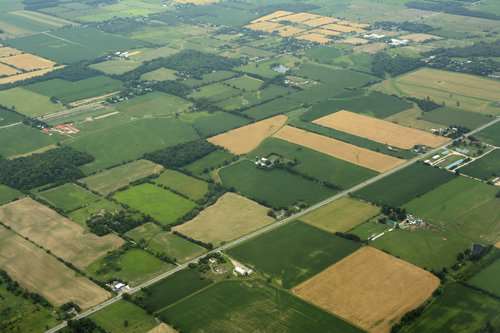The Government released the 2016 Census of Agriculture
By Jennifer Jackson
Although the number of farms reported across Canada has declined yet again in the 2016 Census of Agriculture, the rate of decline is the smallest it has been in the past 20 years.
The census reported 193,492 Canadian farms in 2016 – this value declined by 5.9 per cent from the previous 2011 census, according to Statistic Canada’s 2016 Census of Agriculture, released May 10.
While the number of farms decreased, the size of these farms increased on average to 820 acres per farm in 2016. (This acreage is up from 779 acres in 2011.) The amount of land dedicated to crop production in 2016 also rose to 93.4 million acres – up 6.9 per cent from 2011.
The increase in farm size and farmland is a testament to the innovation of the agricultural industry, according to Erik Dorff, analyst in the agriculture division of Statistics Canada and co-author of the 2016 Census of Agriculture.
“Farmers at the end of the day are business men and women, and they make decisions based on that (fact),” he says. “The drivers that impact companies in other sectors of the economy are the same ones (in agriculture) – efficiency and innovation. These drivers really influence the ag sector.
“With this innovation, (farmers) are able to do more work with less labour and inputs. This (efficiency) allows us to see fewer farm operations and fewer operators (while maintaining) the same amount of productivity.”
Farm size is not the only thing increasing – the value of land and farm buildings across the country has increased to $427.9 billion in 2016, up 37.5 per cent from 2011.
In terms of price per acre, the cross-country average for farmland (including buildings) was $2,696 per acre in 2016. Ontario’s average value for farmland and buildings was $9,580 per acre; for comparison, Saskatchewan’s farmland and buildings averaged $1,210 per acre.
The wide range in farmland value is a result of the varying operation types and demands across the country, according to Dorff.
“We can’t break out the value of the farmland versus the buildings on the land,” he says. “The large Ontario greenhouse sector (contributed largely) to the province’s increase in land value. The greenhouses are expensive buildings with a $32,064 per acre value in Ontario in 2016.”

IMNATURE/iStock/GettyImagesPlus
Statistics Canada provided Farms.com the following cross country farm value comparisons from its 2016 census collection.
Total farm operations:
- Ontario had 49,600 farm operations, altogether worth $118,298,182,459
- Manitoba had 14,791 farm operations, altogether worth $33,845,449,264
- Saskatchewan had 34,523 farm operations, altogether worth $74,546,288,036
- Alberta had 40,638 farm operations, altogether worth $118,286,315,457
- B.C. had 17,528 farm operations, altogether worth $34,058,251,624
Oilseed and grain production:
- Ontario had 16,876 operations worth $54,025,825,849
- Manitoba had 6,703 operations worth $23,408,902,389
- Saskatchewan had 21,505 operations worth $58,395,986,499
- Alberta had 13,451 operations worth $59,450,155,673
- B.C. had 304 operations worth $776,899,724
Dairy cattle and milk production:
- Ontario had 3,439 operations worth $15,055,537,594
- Manitoba had 260 operations worth $924,615,516
- Saskatchewan had 120 operations worth $475,915,701
- Alberta had 411 operations worth $2,026,837,556
- B.C. had 517 operations worth $3,947,823,345
Beef cattle ranching and farming, including feedlots:
- Ontario had 6,786 operations worth $9,651,631,023
- Manitoba had 3,868 operations worth $3,997,535,353
- Saskatchewan had 7,167 operations worth $10,514,487,474
- Alberta had 12,282 operations worth $33,144,091,323
- B.C. had 2,362 operations worth $5,660,992,187
Hog and pig farming:
- Ontario had 1,229 operations worth $5,510,894,485
- Manitoba had 262 operations worth $1,296,878,155
- Saskatchewan had 37 operations worth $168,605,078
- Alberta had 166 operations worth $579,047,767
- B.C. had 101 operations worth $101,206,494
Poultry and egg production:
- Ontario had 1,816 operations worth $5,510,894,485
- Manitoba had 250 operations worth $400,706,121
- Saskatchewan had 101 operations worth $272,640,573
- Alberta had 373 operations worth $989,180,762
- B.C. had 1,220 operations worth $2,097,004,850
Greenhouse, nursery, and floriculture production:
- Ontario had 2,050 operations worth $5,047,838,766
- Manitoba had 192 operations worth $169,978,623
- Saskatchewan had 159 operations worth $122,249,892
- Alberta had 605 operations worth $875,519,430
- B.C. had 1,499 operations worth $2,844,016,465
Vegetable and melon farming:
- Ontario had 1,856 operations worth $4,186,555,833
- Manitoba had 196 operations worth $1,070,321,775
- Saskatchewan had 115 operations worth $75,896,820
- Alberta had 299 operations worth $1,451,373,650
- B.C. had 1,135 operations worth $2,331,018,240
Fruit and tree nut farming:
- Ontario had 1,362 operations worth $2,247,019,878
- Manitoba had 75 operations worth $23,855,360
- Saskatchewan had 90 operations worth $46,653,000
- Alberta had 137 operations worth $85,742,800
- B.C. had 3,180 operations worth $7,442,061,721